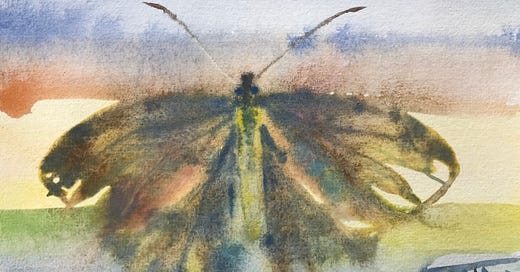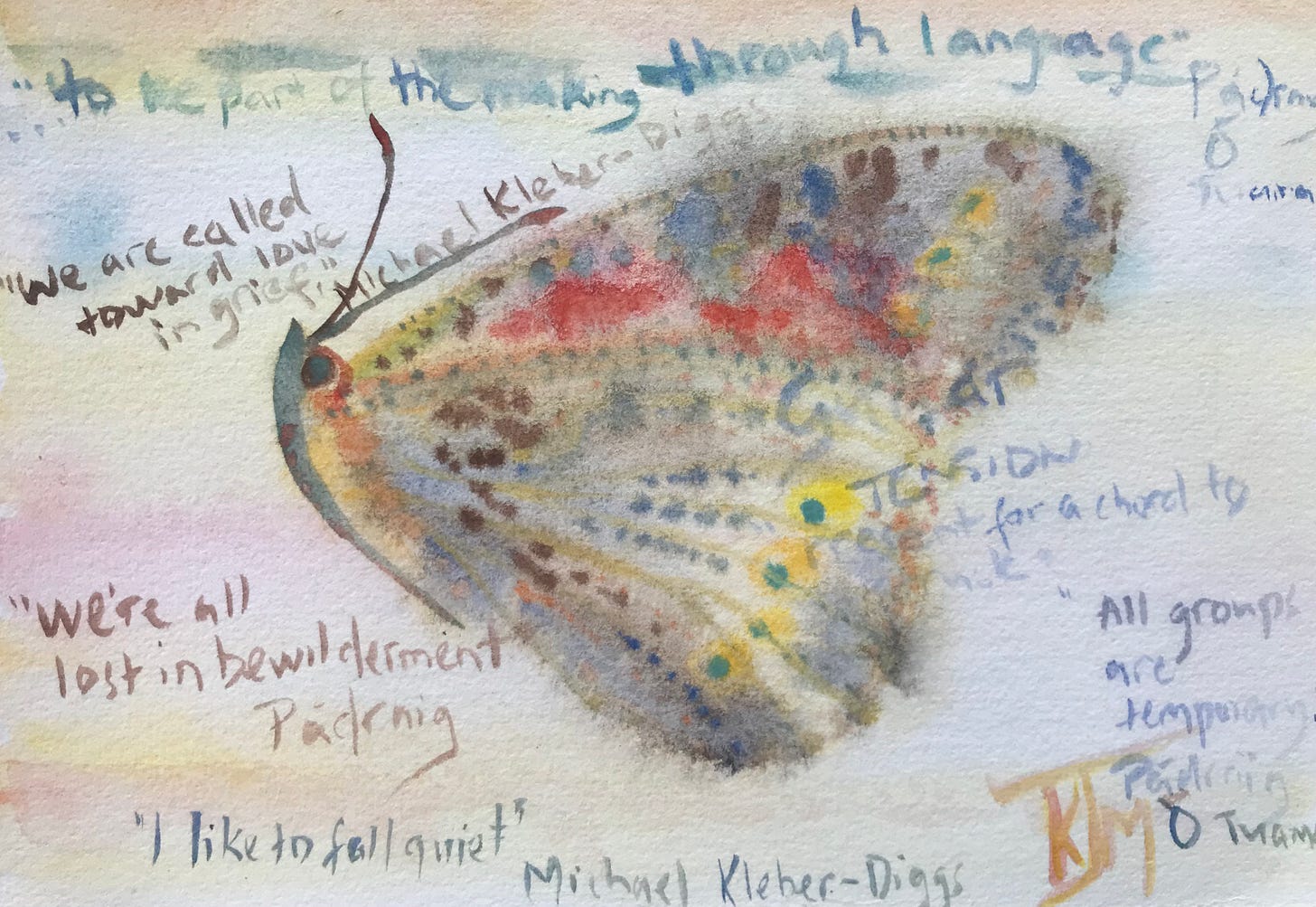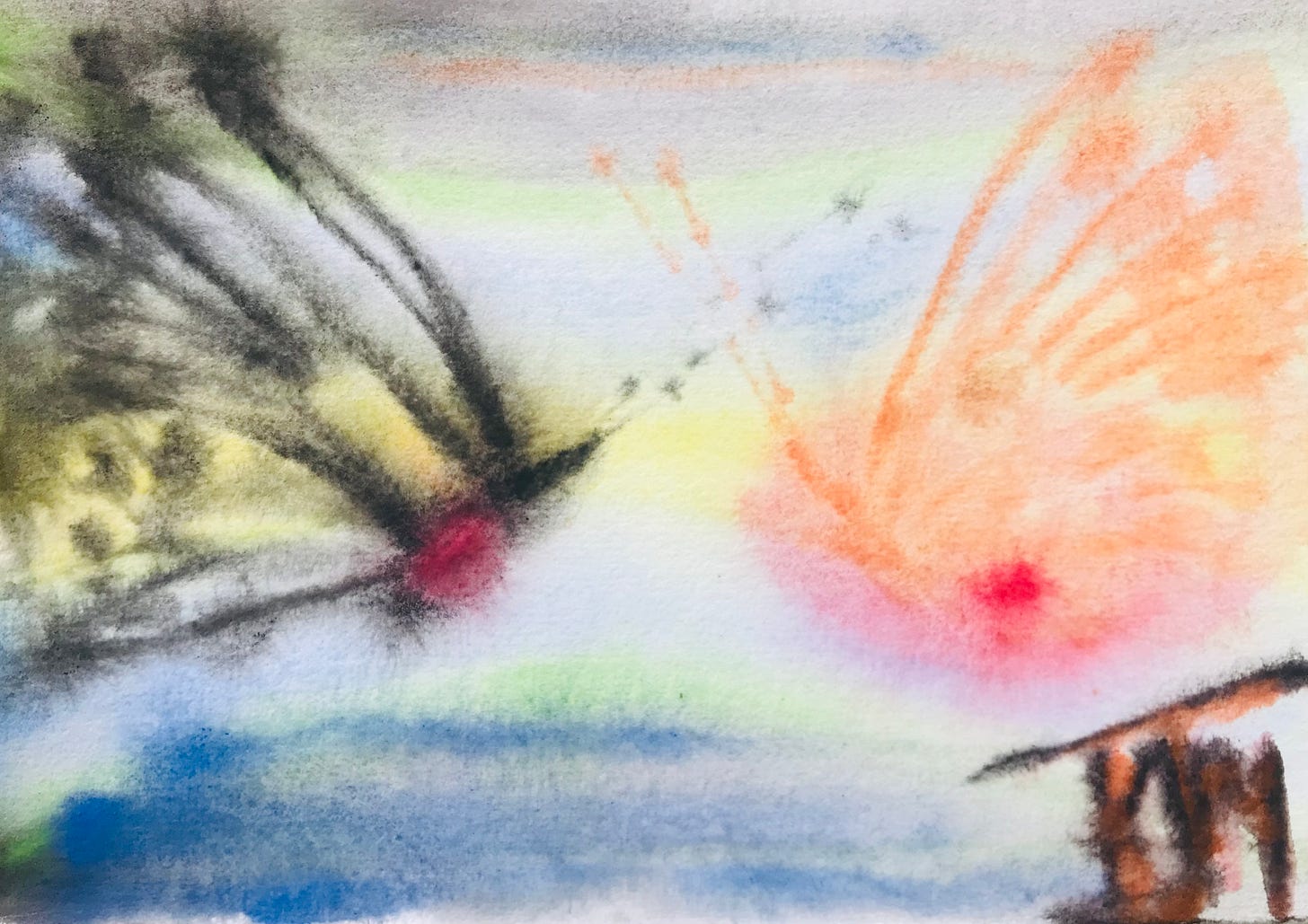Part of the sensitivity of artistic work is sensing when a work is finished. In a poem this can mean the moment when all the pieces click together, and the poem feels like a small sculpture, fully formed and smooth. In a painting this moment is delicate. I’ve learned to stop just before I think it’s finished. I’ve learned that a painting can lose something of its presence, its life, if I keep adding paint; and at other times, the form does not reveal itself until I’ve added another layer, and perhaps another. In this way, a failed painting can become a favourite, or it can remain a mucky mess. I have learned to love all aspects of this enquiry, as the mucky, and the pleasing forms both teach me.
“I like to fall quiet,” Michael Kleber-Diggs said in the recent on-line book launch of 44 Poems on Being with Each Other: A Poetry Unbound Collection by contributing editor Pádraig Ó Tuama. I painted while I listened to Pádraig Ó Tuama and Michael Kleber-Diggs talking, they said many wonderful things in the booklaunch. Some of them I recorded in painting. Mostly though, I listened. Pádraig Ó Tuama said, “We’re all lost in bewilderment.” I find immense comfort in these words, the quiet relief this brings.
Falling Quiet with Others
In 2024 several people responded a question I placed here on Substack about starting a study group to read Brené Brown’s book Rising Strong and to discuss the ideas presented over several weeks. I don’t know what I expected from the group, I do know I was nervous about starting it. What I found out was:
Making art as a way of studying something is super-learning.
Piecing moments-of-art together as a coherent story, is not only a soothing activity, it transforms the ferment of raw material into something tangible and whole.
A small story from my time studying Rising Strong by Brené Brown with a group:
First I painted a stream. Then I painted a moth on the shore of the stream. These paintings were about where we find ourselves, where we are and where we have been. The next painting was of a large tile-like structure representing: the housing-of-stress the moth creature lived underneath, a structure which enclosed the landscape. The fourth painting in this series was: runnels of water beginning to seep into the cracks between the tiles. This represented connection, ideas flowing in from outside, conversation. Next the structure began to disperse in a gentle wind. In the last picture, the moth flew in a vast and streaming sky.
Recipe to start your own Art Study Group
Choose a book (our current book is Grief a Philosophical Guide by Michael Cholbi).
Set up a meeting schedule over the next few months. Our group needs at least two weeks between meetings for reading and making art.
Read the first chapter, meet to discuss it and set an art-making task. Our current task for example, after reading chapter 1 of Grief a Philosophical Guide, is to make something that represents an entry point. The medium can be anything: poetry/prose/collage/sculpture/weaving/paint —whatever.
Bring your art to the next meeting to share. Pretty much the rest of the next meeting will be taken up in sharing and discussing the art.
You may find yourself in a field of awe.Near the end of the meeting, set the next art-making task based on ideas arising from the discussion and interactions of art and reading.
After the class, read the next chapter(s), while also making your art to bring to the following meeting.
The final task for all the sessions is to tell the story you have been making in one page.
On the arrival of the unexpected
At work driving the Bookbus uphill, I notice a very small person in a wheelchair with someone behind, pushing the chair. We are both stopped on red lights. The small person in the wheelchair is wearing large dark sunglasses, and a broad-brimmed hat. I cannot see more than this, but I’m aware of a mutual acknowledgement between us: the person in the small vehicle, me in my enormous one. The lights turn green and I drive on, up to the sunny busy stop where I am rushed off my feet with readers. The Bookbus empties as my time at the stop draws in, and I pause with my hand on the counter, catching my breath before beginning the task of re-shelving.
Into the now quiet space arrives the small person in the wheelchair I had seen at the lights, being wheeled along by a young woman. There’s a moment of hush, then we greet each other. The small person is an older woman with a kind shining face. She is a writer from Japan visiting Dunedin, drawn to a bus filled with books. Her English is superb. After some small talk, she tells me she wrote a book about her life when she was in her thirties, and after the book was published, a reader contacted her — and this meeting changed the course of, and immeasurably enriched her life. She smiled at me, radiant, (literally the conversation was like talking to a glowing ball of light) and said, ‘You should write your book: because it will transform your life.’
*
And if I can phrase all this history again for this moment, for here, through the filter of my own mind: make something to understand the complex and the bewildering. Make something to fall quiet.
Lantern Room
In the lantern room
everyone falls in love.
Bricks placed one by one.
This is what fear looks like.
More wall than fire.
The light though, of a hundred lanterns
brings tenderness even to mortar.
¬ poem by Kirstie McKinnon
A note on the painting Wild Hope
I included this painting in the sequence because I remember feeling a sort of wretched-tired as I painted the first layer. (I had a similar feeling starting this post, wanting to share the idea of the Art Study Group, but feeling clunky and awkward as I tried to describe it). As I painted, a thought of hope as a wild thing loose in the wind came to me, and I added blue and yellow, and let the paint run. The bland colours I started with took on an urgency, a life as the being emerged.
I don’t often ask questions here, but I do wonder: what do you do to fall quiet?
Thank you for reading.
Kirstie







I love what this post says about hope, how it arises from multiple directions, often not obviously linked, but cohering, not explicably, except maybe in art, a painting or in the artistry in this, the making of a post where quiet and exploration matter. Thank you for the question about quiet. It made me think hard about what I do, and by doing that, I discovered some things I hadn't known about what I do. I too stare. At clouds. At trees, - the way light moves on leaves, and sometimes if I have the Concert Programme on, the way trees and wind meet and deepen the music. I realised how much I do this, and how, until your question, I've berated myself for wasting time, not-getting-things-done. I like 'falling' as the verb for this. But more, it's the quiet that falls into me, changing the way my body is, so there's a kind of falling both ways. I'm so glad to learn this. So much hope in just that. Thank you dear Kirstie.
I love the memory of meeting the visiting Japanese lady being “like talking to a glowing ball of light”.
What to I do to fall quiet?
There are so many different silences. But one quietness comes and goes when I walk. Walking for long enough seems to water it and gradually it grows: my mind talks less, listens and looks more, and focuses on care in placing feet, breathing a bit better, and when and what the weather might be about.